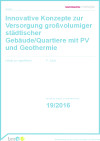Suchergebnisse für "Factsheet: Energietechnologien gestalten, die für alle sinnvoll und nutzbar sind"
urban pv+geotherm - Innovative Konzepte zur Versorgung großvolumiger städtischer Gebäude/Quartiere mit PV und Geothermie
Im städtischen Bereich ist die Nutzung erneuerbarer Energien oft problematisch. Ziel war die Erarbeitung von Konzepten zur energie- und kostenoptimierten Beheizung (und ggf. Kühlung) mittels Geothermie und Photovoltaik für großvolumige Gebäude im städtischen Bereich. Mit den Projekterkenntnissen wird es in Zukunft leichter sein, im urbanen Bereich die Nutzung erneuerbarer Energieträger ökologisch und ökonomisch sinnvoll zu planen.
aspern Die Seestadt Wiens - Subprojekt 3a: Technologiezentrum aspern IQ
Anhand des Demonstrationsgebäudes Technologiezentrum aspern IQ wurde gezeigt, dass der Energiebedarf für die Raumkonditionierung (Heizung, Kühlung, Lüftung, Beleuchtung, Warmwasser) aus Energieeigenproduktion über die Jahresbilanz gedeckt werden kann.
Holzbauweisen für den verdichteten Wohnbau

Kostenbewusste Entwicklung von Bauweisen für den hochverdichteten Wohnungsbau in Holz unter besonderer Berücksichtigung künftiger Bauordnungen (am Beispiel einer 5-geschoßigen Wohnhausanlage in Wien)
Sol2Pump - Hocheffiziente Kombinationen von Solarthermie, Photovoltaik und Wärmepumpenanlagen
Das Projekt beschäftigte sich mit dem Ziel einer möglichst dezentralen Eigenenergieversorgung auf Basis von erneuerbaren Energieformen. Die Kombinationsmöglichkeiten von Solarthermie, Photovoltaik und Wärmepumpe werden tiefgehend analysiert und der Eigenstromverbrauch durch Ausnutzung des Gebäudes als Kurzzeitwärmespeicher maximiert. Im Sinne der Verbrauchsoptimierung sollen mehrere Maßnahmen gesetzt und die Wirkung auf den Energieverbrauch wirtschaftlich bewertet werden.
Innovative Konzepte zur Versorgung großvolumiger städtischer Gebäude/Quartiere mit PV und Geothermie

Schriftenreihe
19/2016
F. Zach
Herausgeber: BMVIT
Deutsch, 83 Seiten
Downloads zur Publikation
urban pv+geotherm - Innovative concepts for the supply of large volume buildings/ quarters with PV and geothermal energy
The use of renewable energies in inner city locations is mostly linked to higher costs andconsidered as problematic. The aim of this project was to optimize (cost and energy) heating (and where required, cooling) using geothermic and photovoltaic for an urban, densely-built development area. With the project´s findings it will be easier to ecologically and economically plan the use of renewable energies especially in urban areas.
aspern Vienna´s Urban Lakeside - subproject 3a: Technology Centre aspern IQ
The demonstration project "Technology centre aspern IQ" showed that the energy required for space conditioning (heating, cooling, ventilation, lighting, hot water) can be covered from domestic energy production.
Timber Passive House at Mühlweg, 1210 Vienna
Low-rise housing with 70 units (200 residents) in solid wood plate construction designed to meet European passive building standards. Strategies for highly ecological and sustainable building within the economic constraints of social housing, Mühlweg, 1210 Vienna. Industrial pre-fabrication, ...
Schiestlhaus, Hochschwab

An integrated (overall) concept for an ecological alpine refuge hut based on solar energy
Rebuilding of the organic farm Achleitner, straw & clay - room climatisation with plants

Rebuilding of a marketing-, store- and processingcenter with an organic freshmart and an organic restaurant in passivhouse quality. Application of regional building materials, an innovatve overall energyconcept, climatisation with plants.
Sol2Pump - High efficient combination of solar thermal plants, photovoltaic and heat pumps
Targeting a high level of decentralised energy supply on basis of renewable energy, the project analysed the possible combinations of solar thermal energy, photovoltaic and heat pumps. The project aimed to maximise the domestic energy supply due to utilisation of the building as short term energy storage. In addition to that, several optimisation measures had been developed. The impact on the energy supply and demand will be economically assessed through life cycle costing. On this basis, the potential load transfer and the use of this kind of systems had been evaluated in combination with smart grids.
